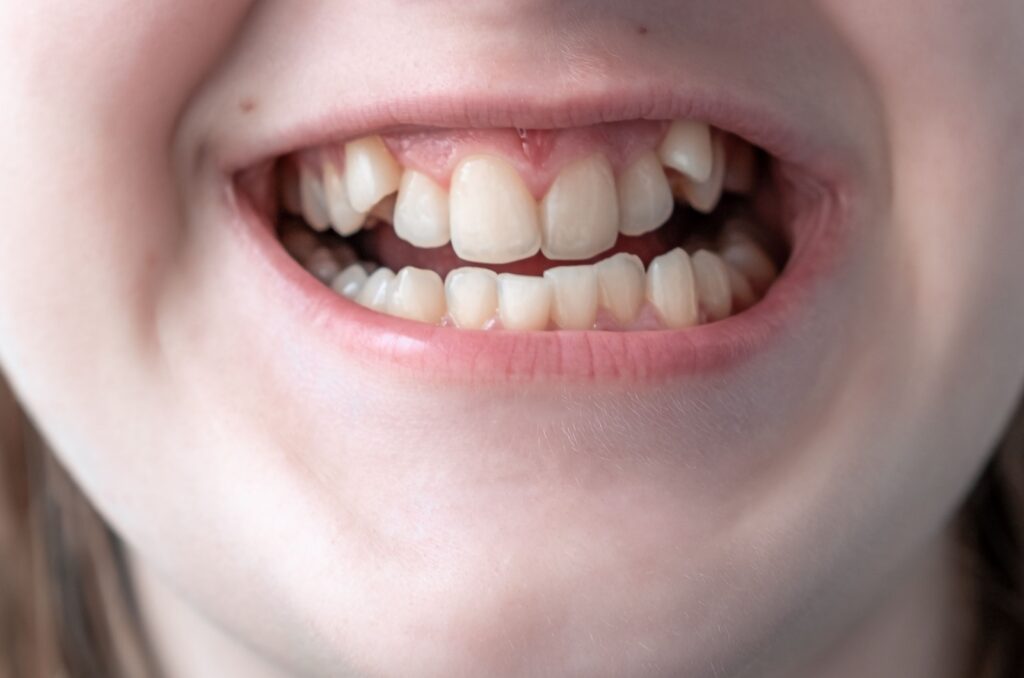Crooked teeth can be more than just a cosmetic concern, they can impact oral health and self-esteem. Several ways to fix crooked teeth include:
- Braces
- Invisalign
- Functional orthodontics
Whether you’re a parent looking out for your child’s dental health or someone wanting to boost their confidence, your dentist can help determine the right orthodontic treatment to achieve a straighter smile.
What Causes Crooked Teeth?
Genetics often play a significant role in dental alignment, such as crooked teeth. Other factors that can cause crooked teeth include certain childhood habits, such as thumb sucking, tongue thrusting, or prolonged use of a pacifier. Early intervention can help mitigate these effects, making it essential for parents to monitor and address these habits.
Untreated Crooked Teeth
Crooked teeth can cause several issues in the mouth and jaw, such as tooth decay, TMJ, and even self-confidence issues. Read on to discover more.
Oral Health Risks
Crooked teeth can create nooks and crannies where plaque and food particles accumulate, increasing the risk of tooth decay and gum disease. Misaligned teeth can also lead to chronic bad breath and other oral health issues.
TMJ Disorders
Misaligned teeth can contribute to temporomandibular joint (TMJ) disorders, causing pain and discomfort in the jaw. Symptoms can include clicking or popping sounds when opening the mouth and pain and difficulty chewing. Addressing crooked teeth can help alleviate these problems and improve overall jaw function.
Psychological Impact
Crooked teeth can have a social and psychological impact. Many people with misaligned teeth feel self-conscious about their appearance, possibly affecting their confidence and social interactions.
How to Fix Crooked Teeth
Specialized dentistry, called orthodontics, can help fix crooked teeth. Several approaches to address the issue include traditional braces, Invisalign, and functional orthodontics. We’ll explore each of these ahead.
Traditional Braces
Traditional metal braces are a tried-and-true method for correcting crooked teeth in children, teens, and adults to improve their smiles and oral health. Traditional braces involve attaching brackets and wires to the teeth that apply gentle pressure to shift teeth in the right position over the treatment time.
You typically wear braces for 2 years. However, treatment times can vary for adults and children based on the severity of misalignment. Braces are highly effective and can address even severe misalignments or bite problems such as:
- Overbites
- Crossbites
- Underbites
- Overjets
- Open bites
However, braces can cause discomfort when first put on and during adjustments. While metal braces can be quite noticeable, you can also now find tooth-coloured ceramic braces, which are less noticeable.
Clear Aligners
Clear aligners, or Invisalign, offer a less visible alternative to traditional braces. Clear aligners are transparent, hard plastic material that fits snugly over the teeth, gradually shifting them into place.
Clear aligners are removable, making it easier to maintain good oral hygiene. However, they require a wear time of at least 22 hours a day. You may feel slight discomfort when changing aligners as your mouth adjusts.
Functional Orthodontics
Functional orthodontics uses appliances to straighten teeth and focuses on correcting the underlying jaw structure to improve dental alignment. This approach often uses appliances like expanders to guide jaw and teeth growth.
Functional orthodontics can be particularly effective for young patients with developing jaws. At an early age, children can be screened to see if functional orthodontics can be effective in helping address teeth and jaw misalignment.
Veneers
For adults looking for a quicker fix, veneers can be an option. Veneers are thin shells of porcelain or composite resin bonded to the front of the teeth. Veneers can provide immediate results for minor misalignment issues but may not address other more serious dental problems.
When to Seek Orthodontic Treatment
Knowing when to seek professional dental advice for crooked teeth is essential. Signs that indicate it’s time to consult your dentist include difficulty chewing, missing teeth, speech impediments, frequent biting of the cheek or tongue, and obvious misalignment of the teeth or jaw.
Importance of Early Evaluation
Encouraging good oral hygiene and addressing harmful habits early on can make a difference in a child’s dental development. Regular dental check-ups can also help identify potential issues before they become more serious.
If you’re unsure whether you or your child needs treatment, consult your dental professional. They can assess your oral health and dental needs and recommend the most suitable treatment options.
Straighter Teeth & Healthier Smiles
Fixing crooked teeth is about more than just achieving a beautiful smile, it’s about improving an individual’s overall health and confidence. Whether you’re dealing with minor misalignment or more severe issues, various treatment options are available to suit your needs and budget.
Don’t wait to take the first step towards a straighter, healthier smile. Book an appointment with Shawnessy Dental Centre to see if you or your child can benefit from orthodontic treatment.


